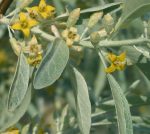 Russian olive, also known as oleaster and oil-tree, is a thorny, deciduous small tree or large shrub growing up to 23’ tall and is native to southern Europe and western and central Asia. It was introduced into central and western US as an ornamental by 1900 where it was been used extensively in windbreaks especially in the Great Plains, and for hedges, snow breaks, soil stabilization, wildlife habitat improvement , and garden plants valued for its flowers, berries, foliage, and bark. The bark is silvery when young turning dark, smooth and exfoliating with age, and the lanceolate to elliptic leaves are green on the top side, silvery on the bottom, and up to four inches long. The small fragrant flowers are silvery white on the outside with yellow inside and produced in axillary clusters of one to three in late spring. They are followed by berry like fruits that resemble olives and are edible and eaten by wildlife. Russian olive is nitrogen fixing and grows well on poor soil. It is drought and salt tolerant and has a high reproductive rate so has become invasive especially in riparian habitats where it has pushed out natives like cottonwoods. It is a member of the Eleagnaceae family that also includes seaberry and buffaloberry. The generic name Eleagnus comes from the Greek words elaia meaning olive and agnos meaning chaste. The specific epithet, angustifolia, comes from the Latin words angustus meaning narrow and folia meaning leaves.
Russian olive, also known as oleaster and oil-tree, is a thorny, deciduous small tree or large shrub growing up to 23’ tall and is native to southern Europe and western and central Asia. It was introduced into central and western US as an ornamental by 1900 where it was been used extensively in windbreaks especially in the Great Plains, and for hedges, snow breaks, soil stabilization, wildlife habitat improvement , and garden plants valued for its flowers, berries, foliage, and bark. The bark is silvery when young turning dark, smooth and exfoliating with age, and the lanceolate to elliptic leaves are green on the top side, silvery on the bottom, and up to four inches long. The small fragrant flowers are silvery white on the outside with yellow inside and produced in axillary clusters of one to three in late spring. They are followed by berry like fruits that resemble olives and are edible and eaten by wildlife. Russian olive is nitrogen fixing and grows well on poor soil. It is drought and salt tolerant and has a high reproductive rate so has become invasive especially in riparian habitats where it has pushed out natives like cottonwoods. It is a member of the Eleagnaceae family that also includes seaberry and buffaloberry. The generic name Eleagnus comes from the Greek words elaia meaning olive and agnos meaning chaste. The specific epithet, angustifolia, comes from the Latin words angustus meaning narrow and folia meaning leaves.
Type: Small tree or large shrub
Outstanding Feature: Silvery leaves, fragrant flowers, edible fruit, exfoliating bar,
Form: Rounded
Growth Rate: Rapid when young, becoming moderate with age
Bloom: Small fragrant flowers, silvery white on the outside with yellow inside, in axillary clusters of one to three in late spring
Size: 12-35’ H x 12-35’ W
Light: Full sun to part shade
Soil: Average, dry to medium moist, well-drained
Hardiness: Zones 3-7
Care: Can be pruned to make hedge
Pests and Diseases: Canker, verticillium wilt, fungal leaf spot, rust
Propagation: Seed, softwood cuttings, hardwood cuttings